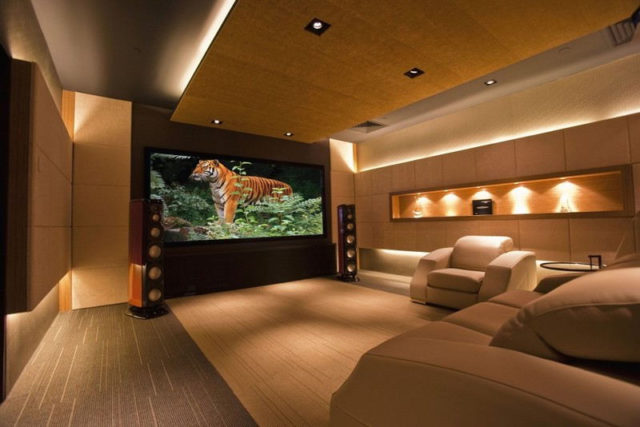Small Space, Big Screen: Home Theater Options for Limited Areas
Establishing a home theater in a constrained area may seem like a challenging venture, but with the right approach, it can be an extremely gratifying adventure. If you have a comfortable corner in your living room or a spare room ready to be transformed, there are numerous options for installing an enveloping movie-watching environment. This guide will take you along everything you need to know about residential cinema installation, from essential elements to design tips that maximize your space.

Numerous homeowners are finding pleasure in their own cinema adventures, spending in tech that can transform their film nights from ordinary to exceptional. As you embark on this path, understanding what’s needed for a fruitful setup will not only help you to create the ideal atmosphere but will also utilize your space. From choosing Home Cinema Amwell Hertfordshire and sound system to thinking about seating options and illumination, we will explore the must-have features for establishing your ideal residential theater, regardless of the space.
Fundamental Residential Theater Elements
Building an outstanding home cinema experience begins with picking the right components to fit your space and tastes. At the center of any home cinema system is the projector. For smaller areas, a high-quality projector with a suitable throw distance can provide a cinematic adventure without crowding the area. Opt for 4K or even 8K displays if your finances allows, as they significantly enhance picture quality, providing vivid colors and crisp detail that will transform movie nights.
Another crucial component is the audio system. Surround sound is crucial for engaging yourself in films, and you can choose from multiple configurations, such as a 5.1-channel or 7.1 setup, depending on your room's configuration and size. For compact areas, explore space-saving speaker options that provide powerful sound without taking up too much room. Wired audio systems may provide better sound quality, while cordless systems offer flexibility and ease of setup; choose which fits best with your design tastes and technical needs.
Lastly, seating can greatly impact the overall environment. Purchase comfortable, cinema-style seating that suits your space and holds the number of guests you expect. Recliners or theater seating can add an extra touch of luxury, while modular options can utilize limited areas. Confirm that your seating is arranged for the ideal viewing angles and sound quality to make the most of your home cinema configuration.
Area Configuration and Setup Advice
Establishing an excellent home theater demands thoughtful attention to room design and arrangement. Begin by picking the best space, ideally a space that can be shaded and is isolated from external sounds. If you have restricted area, reflect on how to maximize it with design choices such as a projector instead of a bulky television, or using wall-mounted shelves for components. An optimal design should allow for relaxed seats while maintaining a clear view of the display from every angle.
As you arranging the space, factor in the screen size and distance from the screen. A typical rule is to set seats at a range that is between 1.5 and 2.5 times the diagonal screen size for the best watching experience. Additionally, think about the layout of the seating; whether you choose reclining seats, divans, or a tiered layout will influence the overall feel and comfort of the room. Confirm that your couches is positioned with the most advantageous viewing height and perspective for the monitor.
Lighting plays a key role in setting the right ambiance for film screenings. Utilize adjustable lighting, wall sconces, or even LED strips for a theatrical ambiance. Refrain from overhead lighting that can produce glare on the display. Incorporate dark curtains or window treatments to manage ambient light and set up a genuine cinematic environment. Remember to further reflect on sound; using acoustic panels can help optimize sound performance, especially in compact rooms where sound can bounce unevenly.
Maintenance and Upgrades for Durability
To ensure your home cinema system continues to provide peak performance, routine maintenance is crucial. Dust and dirt can build up on your devices, leading to overheating and decreased functionality. Make it a habit to clean your gear regularly, including monitors, projectors, and speakers. Additionally, https://zenwriting.net/congocredit8/upgrading-your-perfect-movie-nights-essential-accessories-for-at-home-movie and replace any worn cables to preserve sound and visual quality. This preventive approach will not only extend the lifespan of your technology but also improve your overall watching experience.
Upgrading components is another essential aspect of upkeeping a state-of-the-art home cinema. Over time, audiovisual technology advances rapidly, especially with displays transitioning from 4K to 8K resolution. Think about assessing your system every few years to identify opportunities for upgrades, like replacing an old projector or adding a new surround sound system. Staying updated with the latest technology can significantly enhance your cinematic experience, allowing you to appreciate finer details and richer soundscapes in your favorite films.
Lastly, maintaining your home cinema includes ensuring the room itself in optimal shape. Pay attention to the sound treatments and overall design. If you see sound quality diminishing or display quality lagging, it may be time to reassess your room design. Simple adjustments, such as installing sound-absorbing materials or rearranging furniture, can substantially improve audio and visual output. A well-designed and maintained home cinema will provide enjoyment for many years to come.